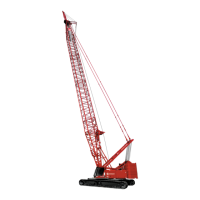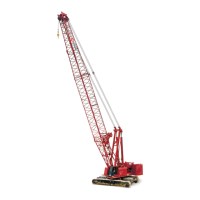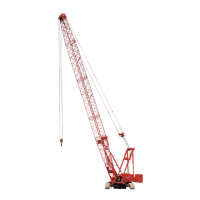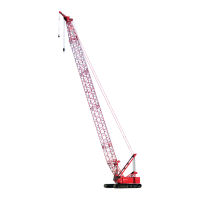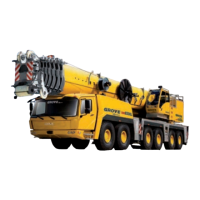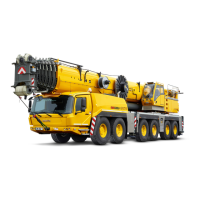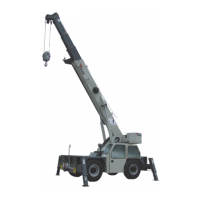
Do you have a question about the Manitowoc Shuttlelift CD5520 and is the answer not in the manual?
| Brand | Manitowoc |
|---|---|
| Model | Shuttlelift CD5520 |
| Category | Construction Equipment |
| Language | English |
Provides information for crane operation and maintenance.
Defines directional terms used in the manual from the operator's perspective.
Details the location and importance of the crane's serial number.
Information on contacting Manitowoc for assistance with products and services.
Presents results from noise and vibration testing for operator comfort.
Identifies and labels major crane components for clarity.
Alerts personnel to hazardous practices and procedures.
Defines requirements for qualified personnel to operate the crane.
Describes systems that provide information or control crane functions.
Ensures safe lifting by considering ground conditions and crane configuration.
Provides maximum allowable loads based on crane configuration and radius.
Details inspection of the work site for safe crane operation.
Explains the impact of wind on crane operation and lifting.
Covers procedures and precautions for safe lifting operations.
Details dangers and precautions when operating near electrical power lines.
Provides guidelines and requirements for lifting personnel with the crane.
Addresses proper disposal of hazardous waste and environmental care.
Highlights the importance of proper maintenance for crane safety.
Details all controls, switches, and gauges for crane operation.
Describes controls located within the operator's cab.
Details the switches and controls on the left side of the dash panel.
Details the switches and controls on the right side of the dash panel.
Explains the function of various indicators and gauges on the instrument panel.
Describes the bubble level for ensuring the crane is properly leveled.
Explains warning lights that monitor engine operating conditions.
Details the system that monitors and limits lifting capacity.
Explains the operation of the outrigger and jack extension/retraction controls.
Describes the different steering modes and their operation.
Provides step-by-step procedures for starting and operating the crane.
Outlines the procedure for safely starting the crane's engine.
Covers procedures and safety precautions for moving the crane.
Explains how to extend, set, and level the crane using outriggers.
Details the operation of controls for boom extension, retraction, and angle.
Covers procedures for raising, lowering, and stopping the hookblock.
Guidelines for safe and efficient load handling and crane movement.
Ensures loads are handled safely according to capacity charts.
Provides safety procedures for lifting personnel using the crane.
Details the steps for safely shutting down the crane.
Explains how to read and utilize the crane's capacity chart.
Defines boom radius and its importance in determining lifting capacity.
Guides the operator to find specific load capacities on the chart.
Highlights critical factors to consider when referencing the capacity chart.
Defines the operational zones for pick and carry maneuvers.
Describes the adjustment of the boom head for different lifting configurations.
Covers procedures for removing and installing the hoist block.
Details the process of attaching and stowing the boom extension.
Step-by-step guide to securely attach the boom extension to the main boom.
Provides instructions for operating the optional manually extendable jib.
Step-by-step guide to safely stow the boom extension.
Describes the installation and removal of the searcher hook assembly.
Covers installation and removal of the down haul weight for load indicators.
Provides instructions for properly installing cable onto the hoist drum.
Details the correct procedure for assembling a wire rope wedge socket.
Explains the process of reeving wire rope for a 4-part line configuration.
General introduction to crane maintenance principles and importance.
Checklist of daily safety equipment inspections required before operation.
Information on recommended lubricants and their application.
Emphasizes the importance of keeping dated records for critical components.
Covers specific maintenance tasks for new cranes and those not in regular use.
Details essential maintenance for new cranes after the initial 50 hours.
Outlines the strategy and importance of regular preventive maintenance.
Provides a comprehensive schedule and checklist for all maintenance intervals.
Identifies all lubrication points and recommended greases for the crane.
Details routine maintenance tasks to be performed at specific intervals.
Covers essential daily checks to ensure safe and proper crane operation.
Explains the critical procedure for inspecting wire rope for wear and damage.
Details the lubrication of grease fittings on various crane components.
Specific instructions for lubricating the wear pads inside the boom sections.
Instructions for lubricating wear pads on the sides and bottom of boom sections.
Guidelines for cleaning the crane to maintain its finish and identify issues.
Procedures for inspecting and repairing damage after cleaning.
General statement that all adjustments must be performed by a qualified mechanic.
Lists the types and quantities of lubricants and fluids required for the crane.
Details the recommended engine oil types, viscosities, and performance standards.
Specifies the type and grade of diesel fuel recommended for the engine.
Provides overall technical specifications for the crane's engine, boom, and electrical systems.
Details tire size, type, air pressure, and wheel nut torque.
Specifies the basic operating weight (GVW) of the crane.
Lists the maximum travel speeds for different gears in two-wheel steer mode.
Provides turning radii and aisle space requirements for different steering modes.

